Critical Analysis of Corporate Social Responsibility
VerifiedAdded on 2021/06/16
|19
|4110
|52
AI Summary
Contribute Materials
Your contribution can guide someone’s learning journey. Share your
documents today.

Running head: ANALYSING CORPORATE SOCIAL RESPONSIBILITY
Analysing Corporate Social Responsibility
Name of the student
Name of the university
Student ID
Author note
Analysing Corporate Social Responsibility
Name of the student
Name of the university
Student ID
Author note
Secure Best Marks with AI Grader
Need help grading? Try our AI Grader for instant feedback on your assignments.
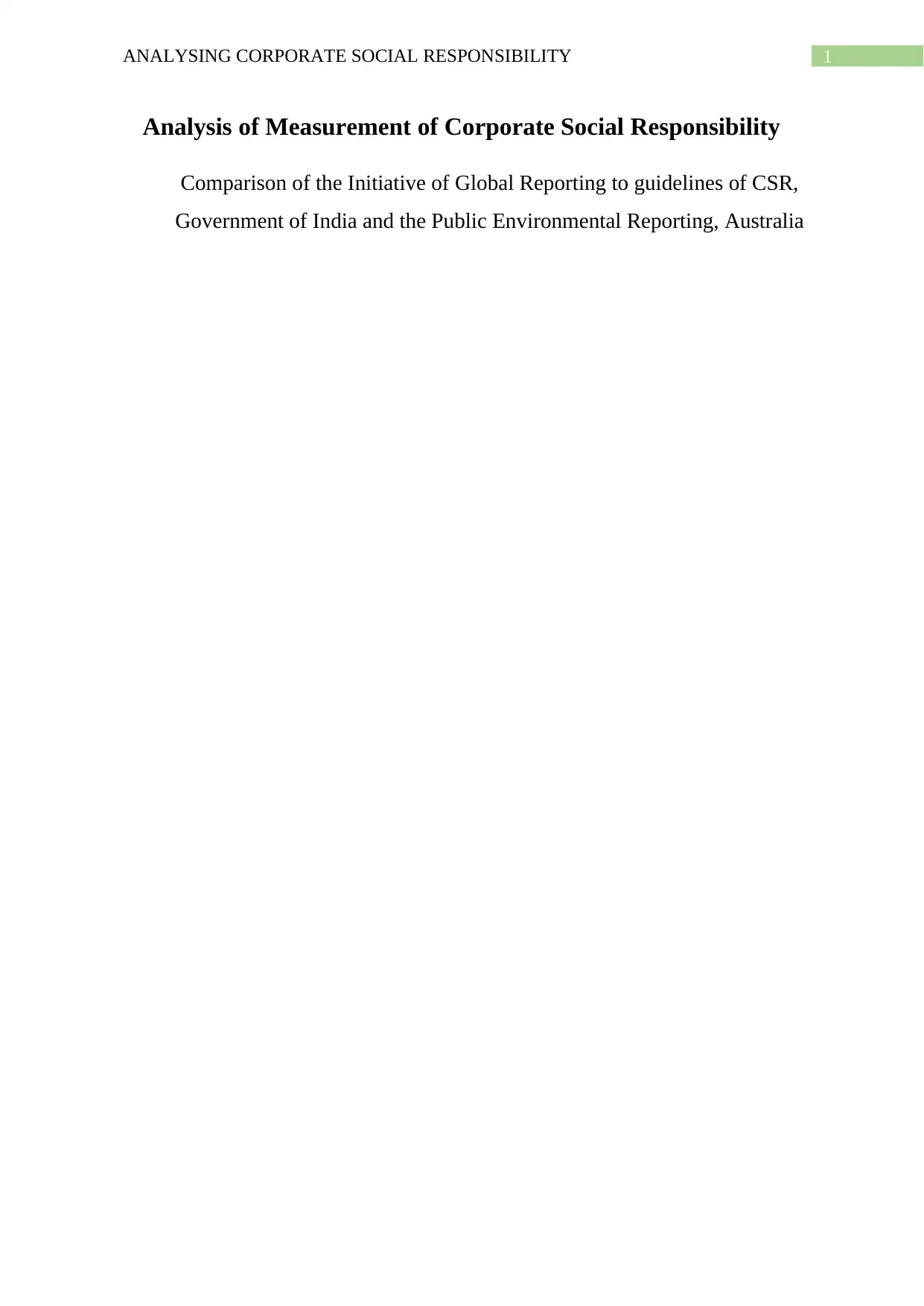
1ANALYSING CORPORATE SOCIAL RESPONSIBILITY
Analysis of Measurement of Corporate Social Responsibility
Comparison of the Initiative of Global Reporting to guidelines of CSR,
Government of India and the Public Environmental Reporting, Australia
Analysis of Measurement of Corporate Social Responsibility
Comparison of the Initiative of Global Reporting to guidelines of CSR,
Government of India and the Public Environmental Reporting, Australia
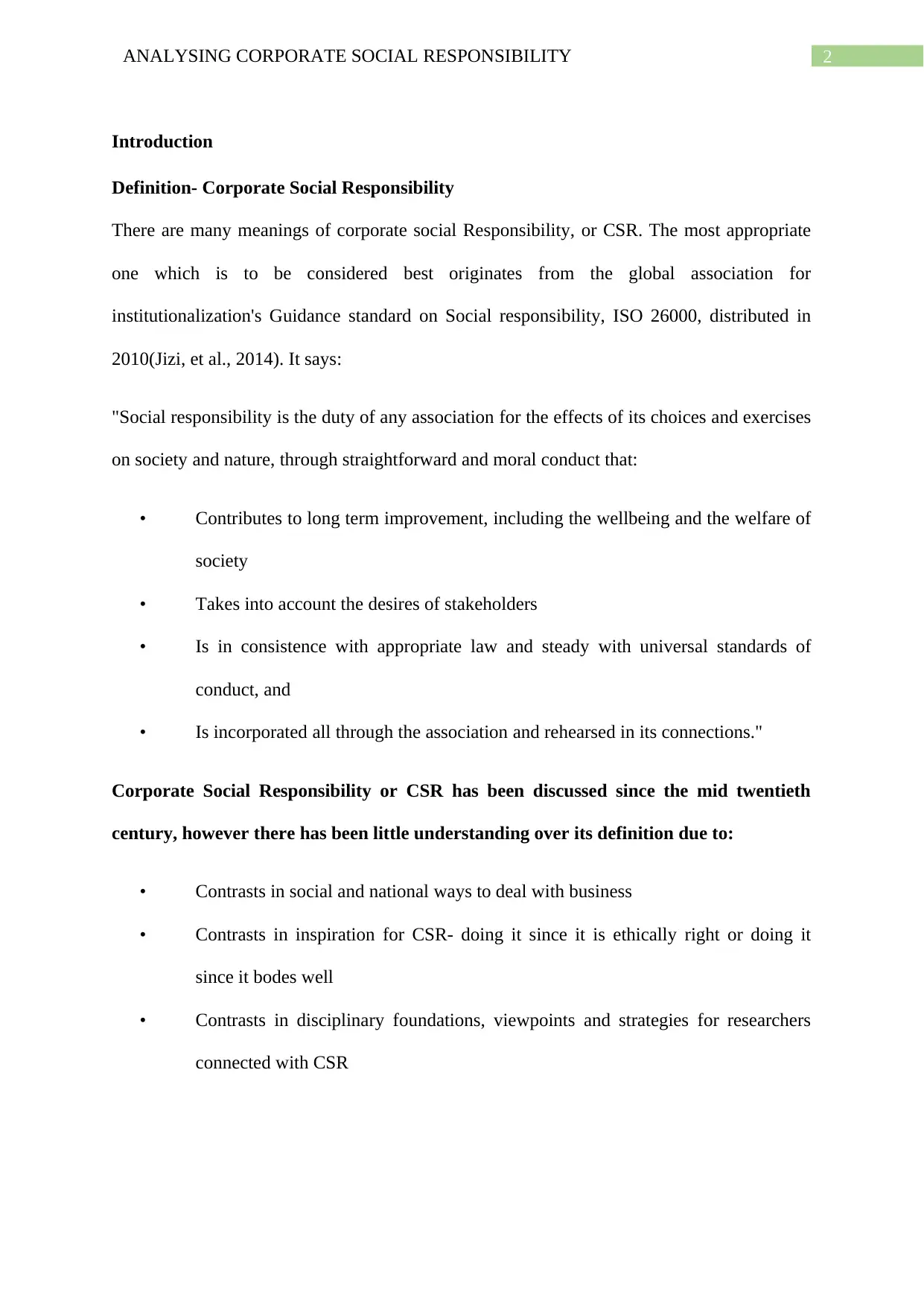
2ANALYSING CORPORATE SOCIAL RESPONSIBILITY
Introduction
Definition- Corporate Social Responsibility
There are many meanings of corporate social Responsibility, or CSR. The most appropriate
one which is to be considered best originates from the global association for
institutionalization's Guidance standard on Social responsibility, ISO 26000, distributed in
2010(Jizi, et al., 2014). It says:
"Social responsibility is the duty of any association for the effects of its choices and exercises
on society and nature, through straightforward and moral conduct that:
• Contributes to long term improvement, including the wellbeing and the welfare of
society
• Takes into account the desires of stakeholders
• Is in consistence with appropriate law and steady with universal standards of
conduct, and
• Is incorporated all through the association and rehearsed in its connections."
Corporate Social Responsibility or CSR has been discussed since the mid twentieth
century, however there has been little understanding over its definition due to:
• Contrasts in social and national ways to deal with business
• Contrasts in inspiration for CSR- doing it since it is ethically right or doing it
since it bodes well
• Contrasts in disciplinary foundations, viewpoints and strategies for researchers
connected with CSR
Introduction
Definition- Corporate Social Responsibility
There are many meanings of corporate social Responsibility, or CSR. The most appropriate
one which is to be considered best originates from the global association for
institutionalization's Guidance standard on Social responsibility, ISO 26000, distributed in
2010(Jizi, et al., 2014). It says:
"Social responsibility is the duty of any association for the effects of its choices and exercises
on society and nature, through straightforward and moral conduct that:
• Contributes to long term improvement, including the wellbeing and the welfare of
society
• Takes into account the desires of stakeholders
• Is in consistence with appropriate law and steady with universal standards of
conduct, and
• Is incorporated all through the association and rehearsed in its connections."
Corporate Social Responsibility or CSR has been discussed since the mid twentieth
century, however there has been little understanding over its definition due to:
• Contrasts in social and national ways to deal with business
• Contrasts in inspiration for CSR- doing it since it is ethically right or doing it
since it bodes well
• Contrasts in disciplinary foundations, viewpoints and strategies for researchers
connected with CSR

3ANALYSING CORPORATE SOCIAL RESPONSIBILITY
A critical comment to make before characterizing CSR is that it is an exceptionally wide
subject with no obvious definition; this makes a great deal of uncertainty. Keeping in mind
the end goal to diminish some uncertainty it is basic to separate CSR into two unique parts
and take a glance at it in a more specific way. Initial segment that will be taken in
consideration is the inner CSR, which is restricted by the extent of the organization, it
manages social strategies of the workers. The second part is the outer CSR, which is in
charge of the outside structure and in this manner manages a substantially more extensive
range than the interior, as it considers all the social and natural elements, sometimes it
dispenses with the disappointments of the experts in the social circle, moving a noteworthy
offer of weight to the organisations.
An example of CSR
Unilever is a multinational organization that deals with food and nutrition is known for its
thorough CSR methodology. The business has been positioned 'Nourishment Industry
pioneer' in the Dow Jones Sustainability World Indexes for the 11 back to back years and
positioned seventh in the 'Worldwide 100 Most Sustainable Corporations in the World'.
One of the main and exceptional actions is the 'sustainable tea' program. On an model based
on association with the Rainforest Alliance (a NGO), Unilever intends to source the greater
part of its Lipton and PG Tips tea packs from Rainforest Alliance Certified™ cultivates by
2015. The Rainforest Alliance Certification offers cultivates an approach to separate their
items as being socially, financially and sustainably environmental (Tai & Chuang, 2014).
A critical comment to make before characterizing CSR is that it is an exceptionally wide
subject with no obvious definition; this makes a great deal of uncertainty. Keeping in mind
the end goal to diminish some uncertainty it is basic to separate CSR into two unique parts
and take a glance at it in a more specific way. Initial segment that will be taken in
consideration is the inner CSR, which is restricted by the extent of the organization, it
manages social strategies of the workers. The second part is the outer CSR, which is in
charge of the outside structure and in this manner manages a substantially more extensive
range than the interior, as it considers all the social and natural elements, sometimes it
dispenses with the disappointments of the experts in the social circle, moving a noteworthy
offer of weight to the organisations.
An example of CSR
Unilever is a multinational organization that deals with food and nutrition is known for its
thorough CSR methodology. The business has been positioned 'Nourishment Industry
pioneer' in the Dow Jones Sustainability World Indexes for the 11 back to back years and
positioned seventh in the 'Worldwide 100 Most Sustainable Corporations in the World'.
One of the main and exceptional actions is the 'sustainable tea' program. On an model based
on association with the Rainforest Alliance (a NGO), Unilever intends to source the greater
part of its Lipton and PG Tips tea packs from Rainforest Alliance Certified™ cultivates by
2015. The Rainforest Alliance Certification offers cultivates an approach to separate their
items as being socially, financially and sustainably environmental (Tai & Chuang, 2014).
Secure Best Marks with AI Grader
Need help grading? Try our AI Grader for instant feedback on your assignments.
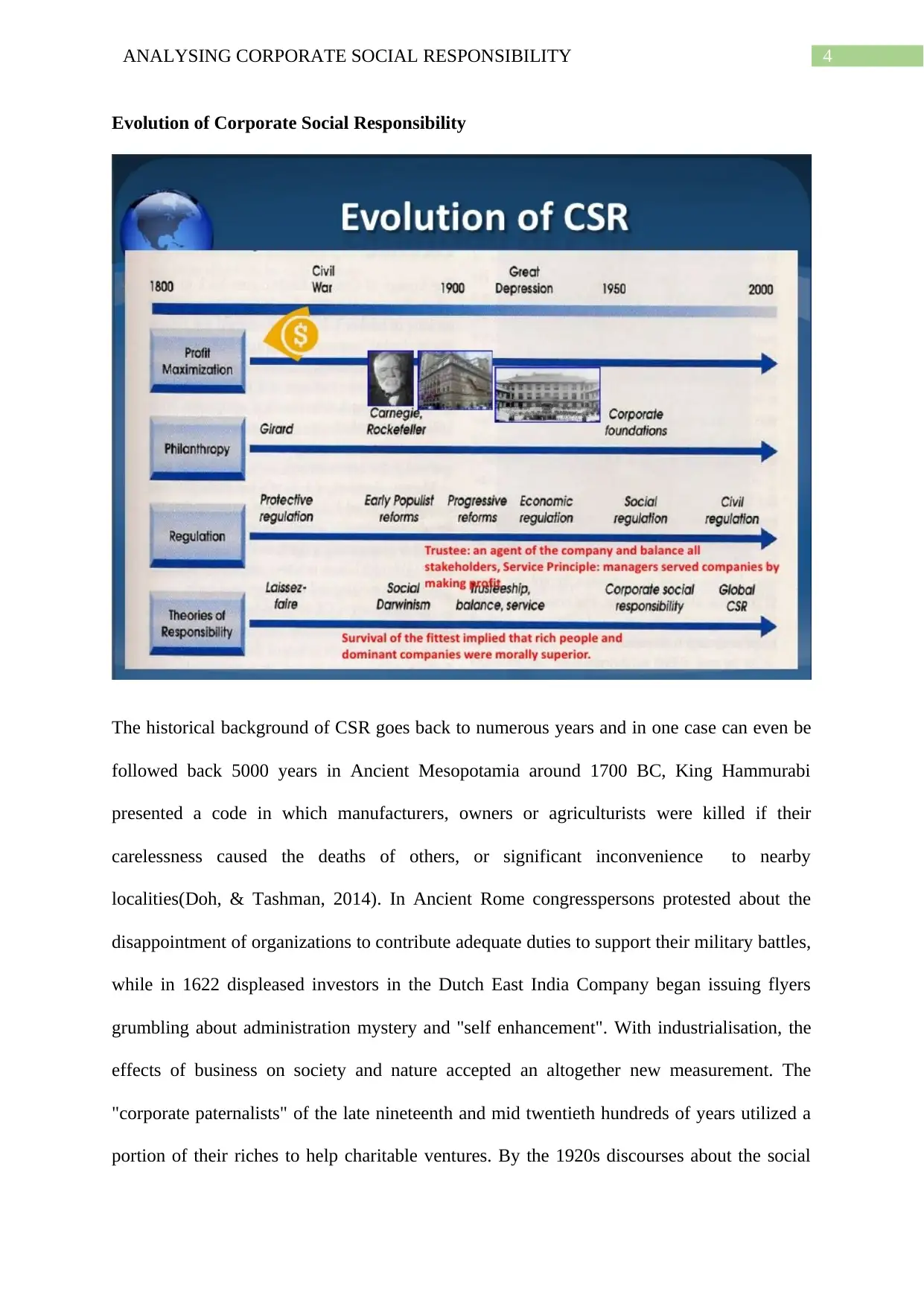
4ANALYSING CORPORATE SOCIAL RESPONSIBILITY
Evolution of Corporate Social Responsibility
The historical background of CSR goes back to numerous years and in one case can even be
followed back 5000 years in Ancient Mesopotamia around 1700 BC, King Hammurabi
presented a code in which manufacturers, owners or agriculturists were killed if their
carelessness caused the deaths of others, or significant inconvenience to nearby
localities(Doh, & Tashman, 2014). In Ancient Rome congresspersons protested about the
disappointment of organizations to contribute adequate duties to support their military battles,
while in 1622 displeased investors in the Dutch East India Company began issuing flyers
grumbling about administration mystery and "self enhancement". With industrialisation, the
effects of business on society and nature accepted an altogether new measurement. The
"corporate paternalists" of the late nineteenth and mid twentieth hundreds of years utilized a
portion of their riches to help charitable ventures. By the 1920s discourses about the social
Evolution of Corporate Social Responsibility
The historical background of CSR goes back to numerous years and in one case can even be
followed back 5000 years in Ancient Mesopotamia around 1700 BC, King Hammurabi
presented a code in which manufacturers, owners or agriculturists were killed if their
carelessness caused the deaths of others, or significant inconvenience to nearby
localities(Doh, & Tashman, 2014). In Ancient Rome congresspersons protested about the
disappointment of organizations to contribute adequate duties to support their military battles,
while in 1622 displeased investors in the Dutch East India Company began issuing flyers
grumbling about administration mystery and "self enhancement". With industrialisation, the
effects of business on society and nature accepted an altogether new measurement. The
"corporate paternalists" of the late nineteenth and mid twentieth hundreds of years utilized a
portion of their riches to help charitable ventures. By the 1920s discourses about the social
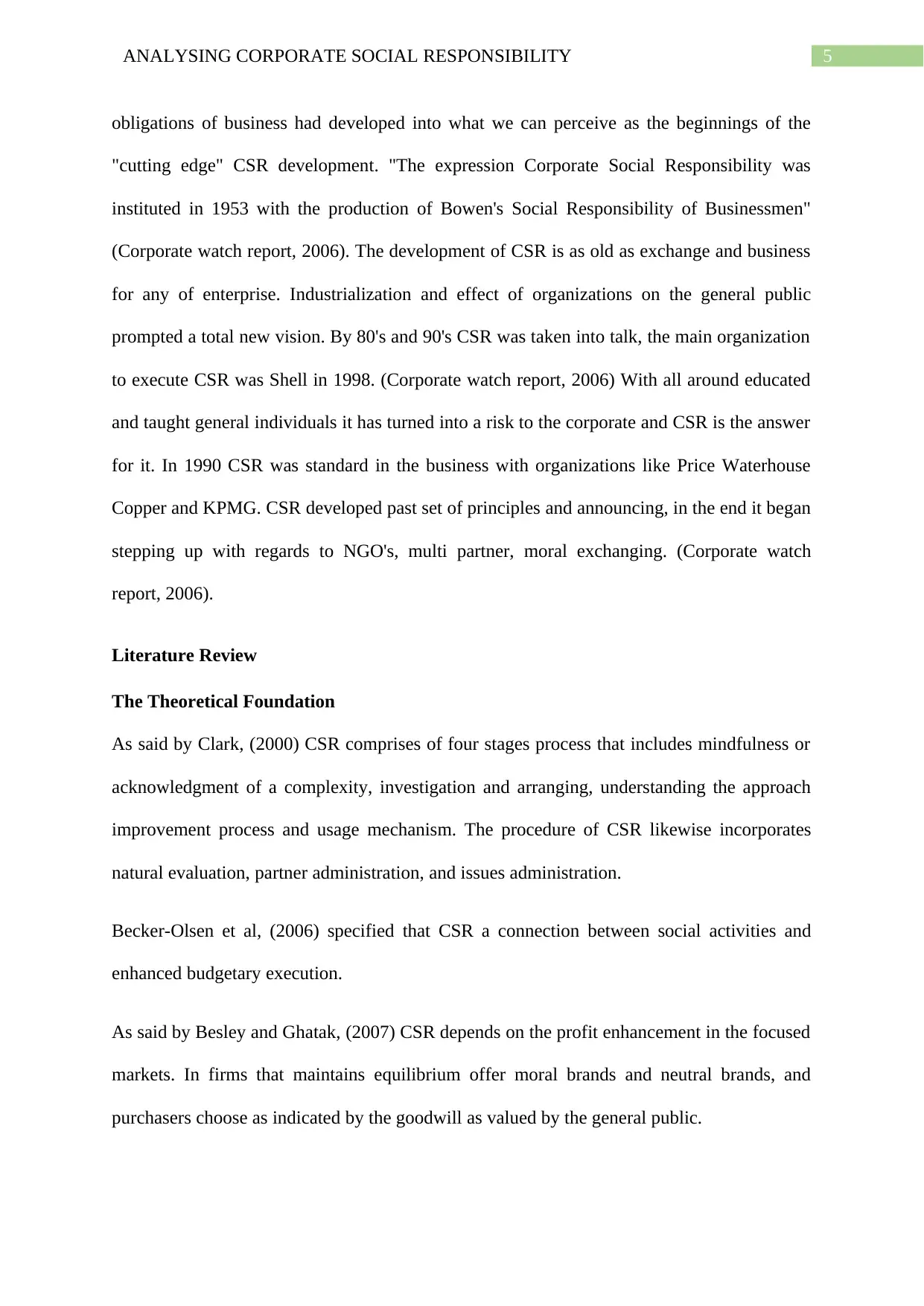
5ANALYSING CORPORATE SOCIAL RESPONSIBILITY
obligations of business had developed into what we can perceive as the beginnings of the
"cutting edge" CSR development. "The expression Corporate Social Responsibility was
instituted in 1953 with the production of Bowen's Social Responsibility of Businessmen"
(Corporate watch report, 2006). The development of CSR is as old as exchange and business
for any of enterprise. Industrialization and effect of organizations on the general public
prompted a total new vision. By 80's and 90's CSR was taken into talk, the main organization
to execute CSR was Shell in 1998. (Corporate watch report, 2006) With all around educated
and taught general individuals it has turned into a risk to the corporate and CSR is the answer
for it. In 1990 CSR was standard in the business with organizations like Price Waterhouse
Copper and KPMG. CSR developed past set of principles and announcing, in the end it began
stepping up with regards to NGO's, multi partner, moral exchanging. (Corporate watch
report, 2006).
Literature Review
The Theoretical Foundation
As said by Clark, (2000) CSR comprises of four stages process that includes mindfulness or
acknowledgment of a complexity, investigation and arranging, understanding the approach
improvement process and usage mechanism. The procedure of CSR likewise incorporates
natural evaluation, partner administration, and issues administration.
Becker-Olsen et al, (2006) specified that CSR a connection between social activities and
enhanced budgetary execution.
As said by Besley and Ghatak, (2007) CSR depends on the profit enhancement in the focused
markets. In firms that maintains equilibrium offer moral brands and neutral brands, and
purchasers choose as indicated by the goodwill as valued by the general public.
obligations of business had developed into what we can perceive as the beginnings of the
"cutting edge" CSR development. "The expression Corporate Social Responsibility was
instituted in 1953 with the production of Bowen's Social Responsibility of Businessmen"
(Corporate watch report, 2006). The development of CSR is as old as exchange and business
for any of enterprise. Industrialization and effect of organizations on the general public
prompted a total new vision. By 80's and 90's CSR was taken into talk, the main organization
to execute CSR was Shell in 1998. (Corporate watch report, 2006) With all around educated
and taught general individuals it has turned into a risk to the corporate and CSR is the answer
for it. In 1990 CSR was standard in the business with organizations like Price Waterhouse
Copper and KPMG. CSR developed past set of principles and announcing, in the end it began
stepping up with regards to NGO's, multi partner, moral exchanging. (Corporate watch
report, 2006).
Literature Review
The Theoretical Foundation
As said by Clark, (2000) CSR comprises of four stages process that includes mindfulness or
acknowledgment of a complexity, investigation and arranging, understanding the approach
improvement process and usage mechanism. The procedure of CSR likewise incorporates
natural evaluation, partner administration, and issues administration.
Becker-Olsen et al, (2006) specified that CSR a connection between social activities and
enhanced budgetary execution.
As said by Besley and Ghatak, (2007) CSR depends on the profit enhancement in the focused
markets. In firms that maintains equilibrium offer moral brands and neutral brands, and
purchasers choose as indicated by the goodwill as valued by the general public.
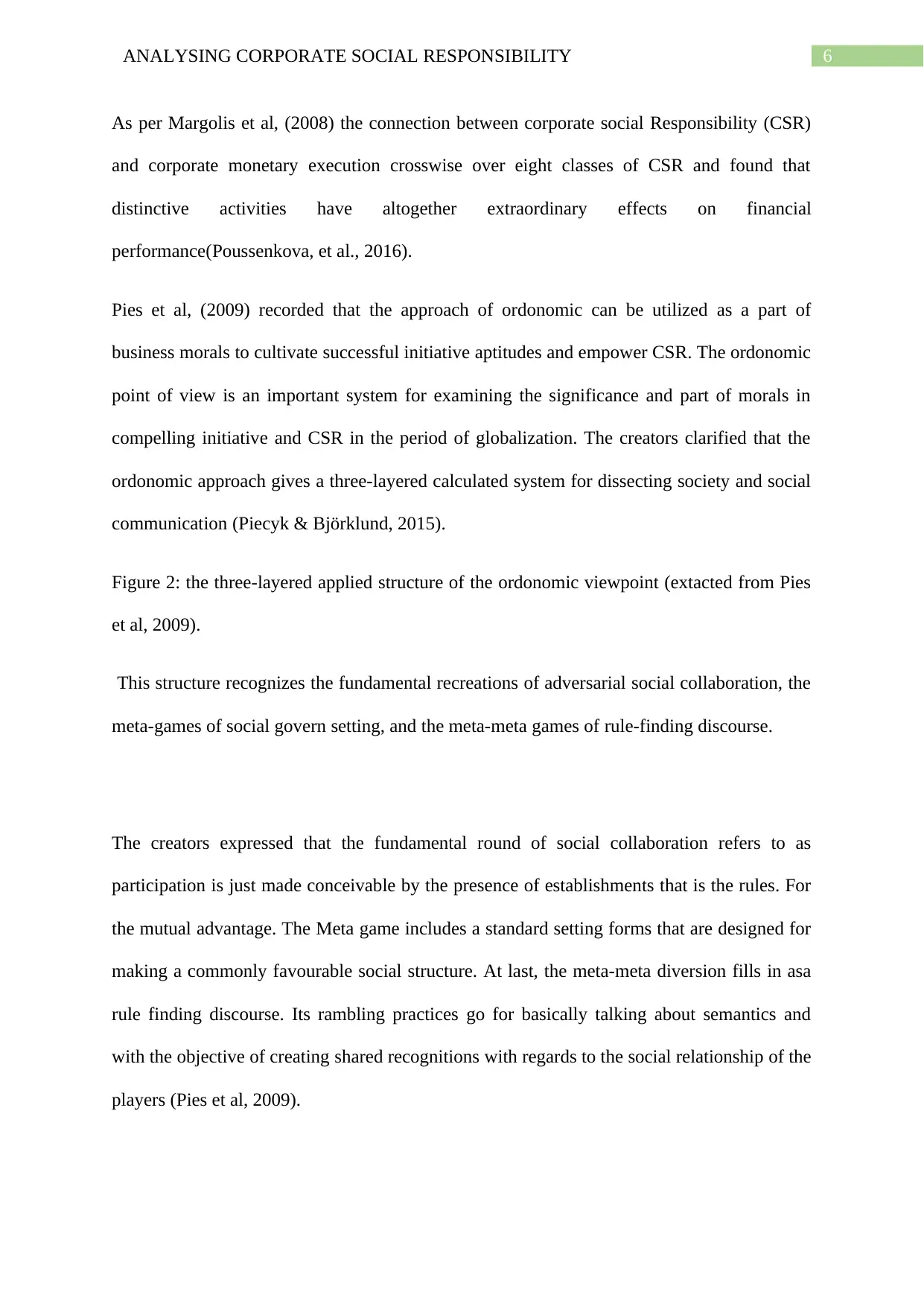
6ANALYSING CORPORATE SOCIAL RESPONSIBILITY
As per Margolis et al, (2008) the connection between corporate social Responsibility (CSR)
and corporate monetary execution crosswise over eight classes of CSR and found that
distinctive activities have altogether extraordinary effects on financial
performance(Poussenkova, et al., 2016).
Pies et al, (2009) recorded that the approach of ordonomic can be utilized as a part of
business morals to cultivate successful initiative aptitudes and empower CSR. The ordonomic
point of view is an important system for examining the significance and part of morals in
compelling initiative and CSR in the period of globalization. The creators clarified that the
ordonomic approach gives a three-layered calculated system for dissecting society and social
communication (Piecyk & Björklund, 2015).
Figure 2: the three-layered applied structure of the ordonomic viewpoint (extacted from Pies
et al, 2009).
This structure recognizes the fundamental recreations of adversarial social collaboration, the
meta-games of social govern setting, and the meta-meta games of rule-finding discourse.
The creators expressed that the fundamental round of social collaboration refers to as
participation is just made conceivable by the presence of establishments that is the rules. For
the mutual advantage. The Meta game includes a standard setting forms that are designed for
making a commonly favourable social structure. At last, the meta-meta diversion fills in asa
rule finding discourse. Its rambling practices go for basically talking about semantics and
with the objective of creating shared recognitions with regards to the social relationship of the
players (Pies et al, 2009).
As per Margolis et al, (2008) the connection between corporate social Responsibility (CSR)
and corporate monetary execution crosswise over eight classes of CSR and found that
distinctive activities have altogether extraordinary effects on financial
performance(Poussenkova, et al., 2016).
Pies et al, (2009) recorded that the approach of ordonomic can be utilized as a part of
business morals to cultivate successful initiative aptitudes and empower CSR. The ordonomic
point of view is an important system for examining the significance and part of morals in
compelling initiative and CSR in the period of globalization. The creators clarified that the
ordonomic approach gives a three-layered calculated system for dissecting society and social
communication (Piecyk & Björklund, 2015).
Figure 2: the three-layered applied structure of the ordonomic viewpoint (extacted from Pies
et al, 2009).
This structure recognizes the fundamental recreations of adversarial social collaboration, the
meta-games of social govern setting, and the meta-meta games of rule-finding discourse.
The creators expressed that the fundamental round of social collaboration refers to as
participation is just made conceivable by the presence of establishments that is the rules. For
the mutual advantage. The Meta game includes a standard setting forms that are designed for
making a commonly favourable social structure. At last, the meta-meta diversion fills in asa
rule finding discourse. Its rambling practices go for basically talking about semantics and
with the objective of creating shared recognitions with regards to the social relationship of the
players (Pies et al, 2009).
Paraphrase This Document
Need a fresh take? Get an instant paraphrase of this document with our AI Paraphraser
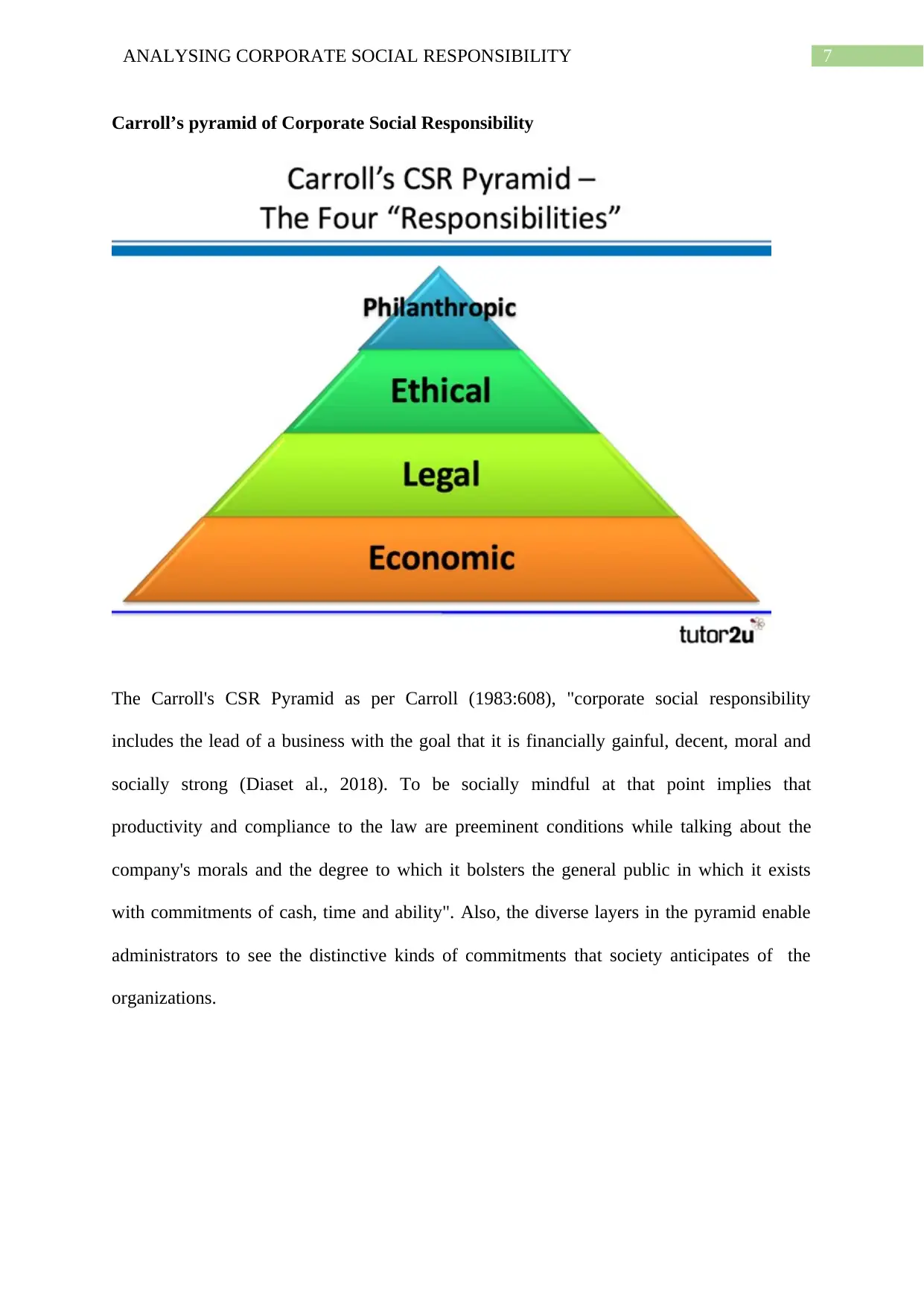
7ANALYSING CORPORATE SOCIAL RESPONSIBILITY
Carroll’s pyramid of Corporate Social Responsibility
The Carroll's CSR Pyramid as per Carroll (1983:608), "corporate social responsibility
includes the lead of a business with the goal that it is financially gainful, decent, moral and
socially strong (Diaset al., 2018). To be socially mindful at that point implies that
productivity and compliance to the law are preeminent conditions while talking about the
company's morals and the degree to which it bolsters the general public in which it exists
with commitments of cash, time and ability". Also, the diverse layers in the pyramid enable
administrators to see the distinctive kinds of commitments that society anticipates of the
organizations.
Carroll’s pyramid of Corporate Social Responsibility
The Carroll's CSR Pyramid as per Carroll (1983:608), "corporate social responsibility
includes the lead of a business with the goal that it is financially gainful, decent, moral and
socially strong (Diaset al., 2018). To be socially mindful at that point implies that
productivity and compliance to the law are preeminent conditions while talking about the
company's morals and the degree to which it bolsters the general public in which it exists
with commitments of cash, time and ability". Also, the diverse layers in the pyramid enable
administrators to see the distinctive kinds of commitments that society anticipates of the
organizations.
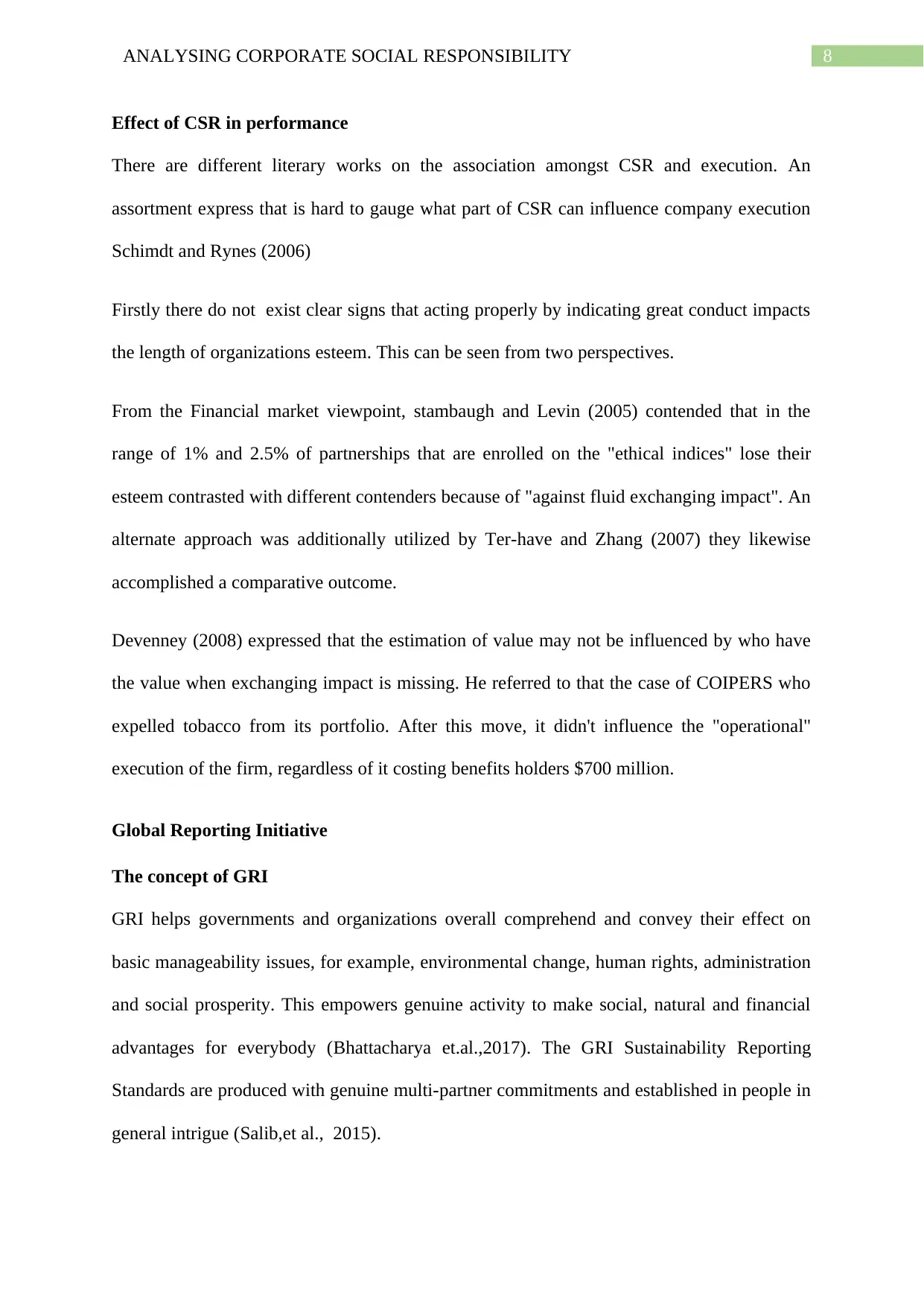
8ANALYSING CORPORATE SOCIAL RESPONSIBILITY
Effect of CSR in performance
There are different literary works on the association amongst CSR and execution. An
assortment express that is hard to gauge what part of CSR can influence company execution
Schimdt and Rynes (2006)
Firstly there do not exist clear signs that acting properly by indicating great conduct impacts
the length of organizations esteem. This can be seen from two perspectives.
From the Financial market viewpoint, stambaugh and Levin (2005) contended that in the
range of 1% and 2.5% of partnerships that are enrolled on the "ethical indices" lose their
esteem contrasted with different contenders because of "against fluid exchanging impact". An
alternate approach was additionally utilized by Ter-have and Zhang (2007) they likewise
accomplished a comparative outcome.
Devenney (2008) expressed that the estimation of value may not be influenced by who have
the value when exchanging impact is missing. He referred to that the case of COIPERS who
expelled tobacco from its portfolio. After this move, it didn't influence the "operational"
execution of the firm, regardless of it costing benefits holders $700 million.
Global Reporting Initiative
The concept of GRI
GRI helps governments and organizations overall comprehend and convey their effect on
basic manageability issues, for example, environmental change, human rights, administration
and social prosperity. This empowers genuine activity to make social, natural and financial
advantages for everybody (Bhattacharya et.al.,2017). The GRI Sustainability Reporting
Standards are produced with genuine multi-partner commitments and established in people in
general intrigue (Salib,et al., 2015).
Effect of CSR in performance
There are different literary works on the association amongst CSR and execution. An
assortment express that is hard to gauge what part of CSR can influence company execution
Schimdt and Rynes (2006)
Firstly there do not exist clear signs that acting properly by indicating great conduct impacts
the length of organizations esteem. This can be seen from two perspectives.
From the Financial market viewpoint, stambaugh and Levin (2005) contended that in the
range of 1% and 2.5% of partnerships that are enrolled on the "ethical indices" lose their
esteem contrasted with different contenders because of "against fluid exchanging impact". An
alternate approach was additionally utilized by Ter-have and Zhang (2007) they likewise
accomplished a comparative outcome.
Devenney (2008) expressed that the estimation of value may not be influenced by who have
the value when exchanging impact is missing. He referred to that the case of COIPERS who
expelled tobacco from its portfolio. After this move, it didn't influence the "operational"
execution of the firm, regardless of it costing benefits holders $700 million.
Global Reporting Initiative
The concept of GRI
GRI helps governments and organizations overall comprehend and convey their effect on
basic manageability issues, for example, environmental change, human rights, administration
and social prosperity. This empowers genuine activity to make social, natural and financial
advantages for everybody (Bhattacharya et.al.,2017). The GRI Sustainability Reporting
Standards are produced with genuine multi-partner commitments and established in people in
general intrigue (Salib,et al., 2015).
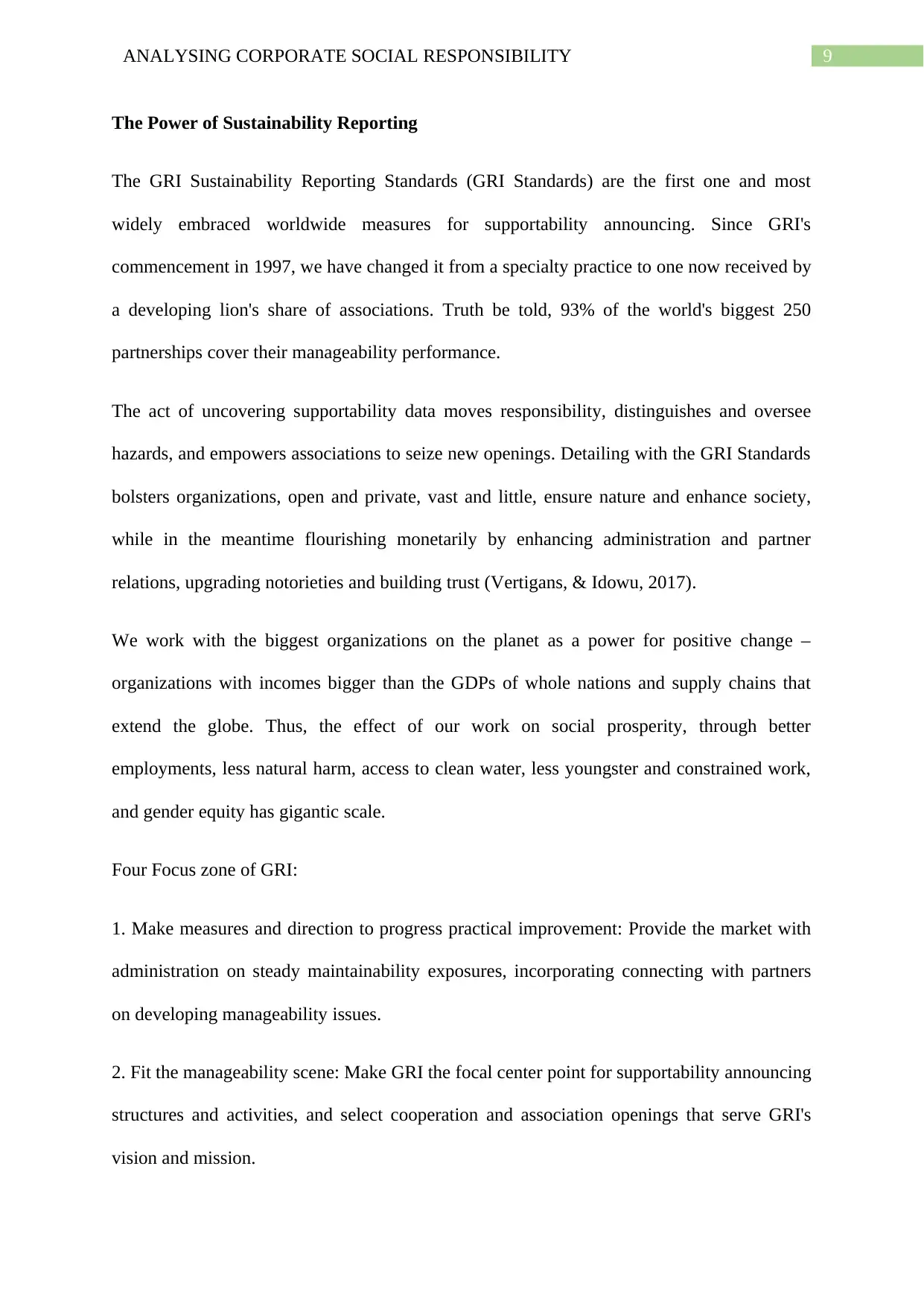
9ANALYSING CORPORATE SOCIAL RESPONSIBILITY
The Power of Sustainability Reporting
The GRI Sustainability Reporting Standards (GRI Standards) are the first one and most
widely embraced worldwide measures for supportability announcing. Since GRI's
commencement in 1997, we have changed it from a specialty practice to one now received by
a developing lion's share of associations. Truth be told, 93% of the world's biggest 250
partnerships cover their manageability performance.
The act of uncovering supportability data moves responsibility, distinguishes and oversee
hazards, and empowers associations to seize new openings. Detailing with the GRI Standards
bolsters organizations, open and private, vast and little, ensure nature and enhance society,
while in the meantime flourishing monetarily by enhancing administration and partner
relations, upgrading notorieties and building trust (Vertigans, & Idowu, 2017).
We work with the biggest organizations on the planet as a power for positive change –
organizations with incomes bigger than the GDPs of whole nations and supply chains that
extend the globe. Thus, the effect of our work on social prosperity, through better
employments, less natural harm, access to clean water, less youngster and constrained work,
and gender equity has gigantic scale.
Four Focus zone of GRI:
1. Make measures and direction to progress practical improvement: Provide the market with
administration on steady maintainability exposures, incorporating connecting with partners
on developing manageability issues.
2. Fit the manageability scene: Make GRI the focal center point for supportability announcing
structures and activities, and select cooperation and association openings that serve GRI's
vision and mission.
The Power of Sustainability Reporting
The GRI Sustainability Reporting Standards (GRI Standards) are the first one and most
widely embraced worldwide measures for supportability announcing. Since GRI's
commencement in 1997, we have changed it from a specialty practice to one now received by
a developing lion's share of associations. Truth be told, 93% of the world's biggest 250
partnerships cover their manageability performance.
The act of uncovering supportability data moves responsibility, distinguishes and oversee
hazards, and empowers associations to seize new openings. Detailing with the GRI Standards
bolsters organizations, open and private, vast and little, ensure nature and enhance society,
while in the meantime flourishing monetarily by enhancing administration and partner
relations, upgrading notorieties and building trust (Vertigans, & Idowu, 2017).
We work with the biggest organizations on the planet as a power for positive change –
organizations with incomes bigger than the GDPs of whole nations and supply chains that
extend the globe. Thus, the effect of our work on social prosperity, through better
employments, less natural harm, access to clean water, less youngster and constrained work,
and gender equity has gigantic scale.
Four Focus zone of GRI:
1. Make measures and direction to progress practical improvement: Provide the market with
administration on steady maintainability exposures, incorporating connecting with partners
on developing manageability issues.
2. Fit the manageability scene: Make GRI the focal center point for supportability announcing
structures and activities, and select cooperation and association openings that serve GRI's
vision and mission.
Secure Best Marks with AI Grader
Need help grading? Try our AI Grader for instant feedback on your assignments.
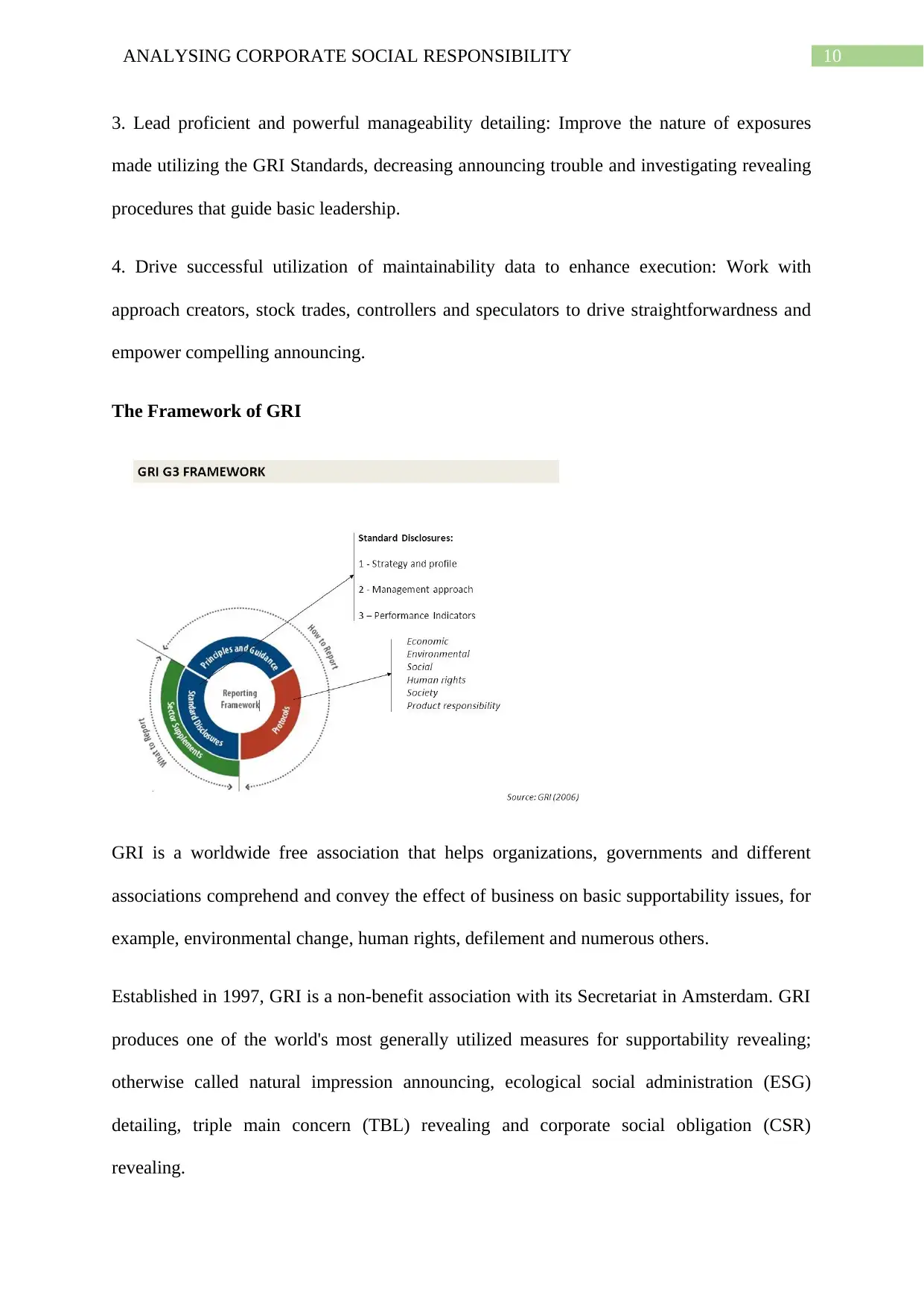
10ANALYSING CORPORATE SOCIAL RESPONSIBILITY
3. Lead proficient and powerful manageability detailing: Improve the nature of exposures
made utilizing the GRI Standards, decreasing announcing trouble and investigating revealing
procedures that guide basic leadership.
4. Drive successful utilization of maintainability data to enhance execution: Work with
approach creators, stock trades, controllers and speculators to drive straightforwardness and
empower compelling announcing.
The Framework of GRI
GRI is a worldwide free association that helps organizations, governments and different
associations comprehend and convey the effect of business on basic supportability issues, for
example, environmental change, human rights, defilement and numerous others.
Established in 1997, GRI is a non-benefit association with its Secretariat in Amsterdam. GRI
produces one of the world's most generally utilized measures for supportability revealing;
otherwise called natural impression announcing, ecological social administration (ESG)
detailing, triple main concern (TBL) revealing and corporate social obligation (CSR)
revealing.
3. Lead proficient and powerful manageability detailing: Improve the nature of exposures
made utilizing the GRI Standards, decreasing announcing trouble and investigating revealing
procedures that guide basic leadership.
4. Drive successful utilization of maintainability data to enhance execution: Work with
approach creators, stock trades, controllers and speculators to drive straightforwardness and
empower compelling announcing.
The Framework of GRI
GRI is a worldwide free association that helps organizations, governments and different
associations comprehend and convey the effect of business on basic supportability issues, for
example, environmental change, human rights, defilement and numerous others.
Established in 1997, GRI is a non-benefit association with its Secretariat in Amsterdam. GRI
produces one of the world's most generally utilized measures for supportability revealing;
otherwise called natural impression announcing, ecological social administration (ESG)
detailing, triple main concern (TBL) revealing and corporate social obligation (CSR)
revealing.
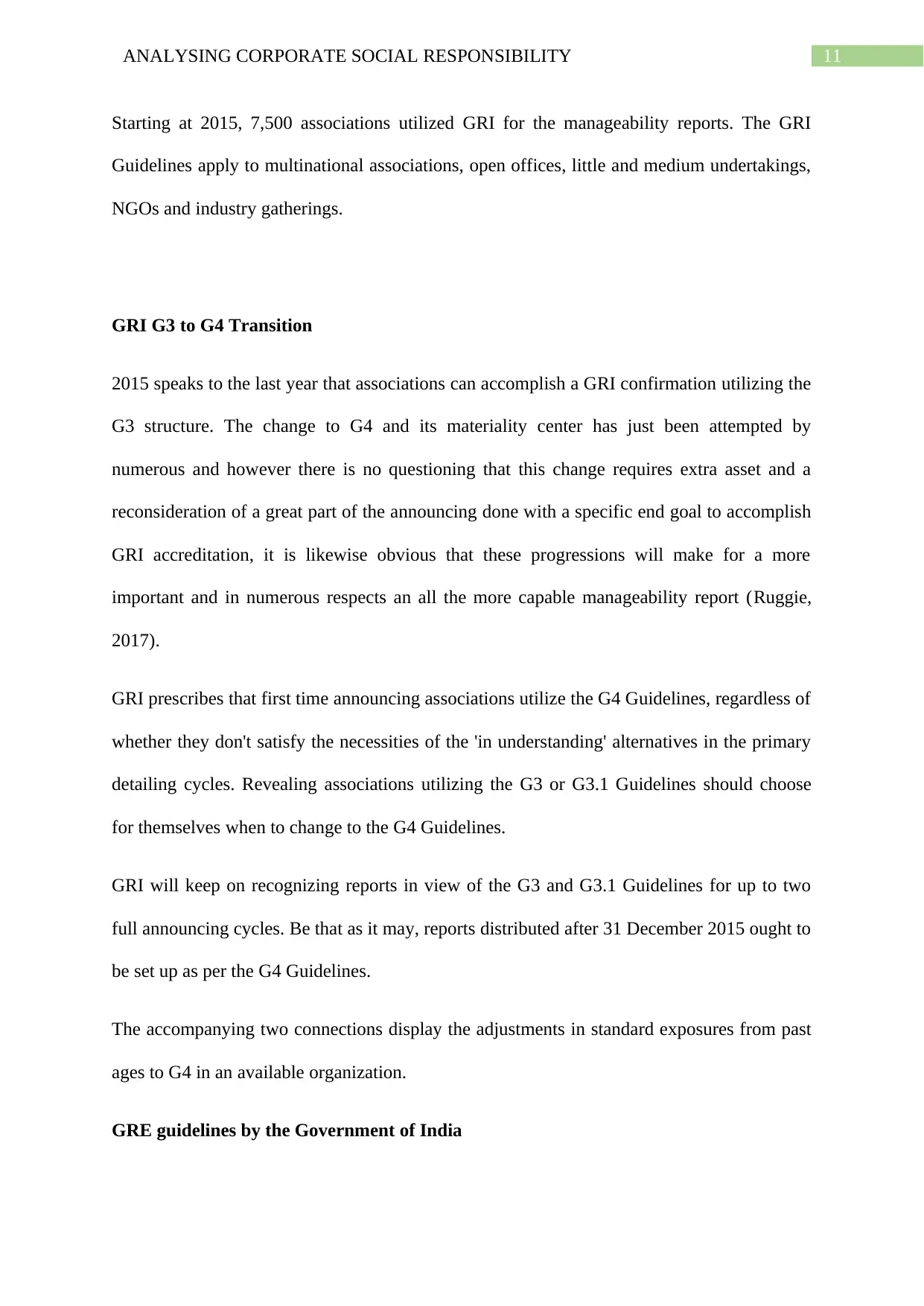
11ANALYSING CORPORATE SOCIAL RESPONSIBILITY
Starting at 2015, 7,500 associations utilized GRI for the manageability reports. The GRI
Guidelines apply to multinational associations, open offices, little and medium undertakings,
NGOs and industry gatherings.
GRI G3 to G4 Transition
2015 speaks to the last year that associations can accomplish a GRI confirmation utilizing the
G3 structure. The change to G4 and its materiality center has just been attempted by
numerous and however there is no questioning that this change requires extra asset and a
reconsideration of a great part of the announcing done with a specific end goal to accomplish
GRI accreditation, it is likewise obvious that these progressions will make for a more
important and in numerous respects an all the more capable manageability report (Ruggie,
2017).
GRI prescribes that first time announcing associations utilize the G4 Guidelines, regardless of
whether they don't satisfy the necessities of the 'in understanding' alternatives in the primary
detailing cycles. Revealing associations utilizing the G3 or G3.1 Guidelines should choose
for themselves when to change to the G4 Guidelines.
GRI will keep on recognizing reports in view of the G3 and G3.1 Guidelines for up to two
full announcing cycles. Be that as it may, reports distributed after 31 December 2015 ought to
be set up as per the G4 Guidelines.
The accompanying two connections display the adjustments in standard exposures from past
ages to G4 in an available organization.
GRE guidelines by the Government of India
Starting at 2015, 7,500 associations utilized GRI for the manageability reports. The GRI
Guidelines apply to multinational associations, open offices, little and medium undertakings,
NGOs and industry gatherings.
GRI G3 to G4 Transition
2015 speaks to the last year that associations can accomplish a GRI confirmation utilizing the
G3 structure. The change to G4 and its materiality center has just been attempted by
numerous and however there is no questioning that this change requires extra asset and a
reconsideration of a great part of the announcing done with a specific end goal to accomplish
GRI accreditation, it is likewise obvious that these progressions will make for a more
important and in numerous respects an all the more capable manageability report (Ruggie,
2017).
GRI prescribes that first time announcing associations utilize the G4 Guidelines, regardless of
whether they don't satisfy the necessities of the 'in understanding' alternatives in the primary
detailing cycles. Revealing associations utilizing the G3 or G3.1 Guidelines should choose
for themselves when to change to the G4 Guidelines.
GRI will keep on recognizing reports in view of the G3 and G3.1 Guidelines for up to two
full announcing cycles. Be that as it may, reports distributed after 31 December 2015 ought to
be set up as per the G4 Guidelines.
The accompanying two connections display the adjustments in standard exposures from past
ages to G4 in an available organization.
GRE guidelines by the Government of India
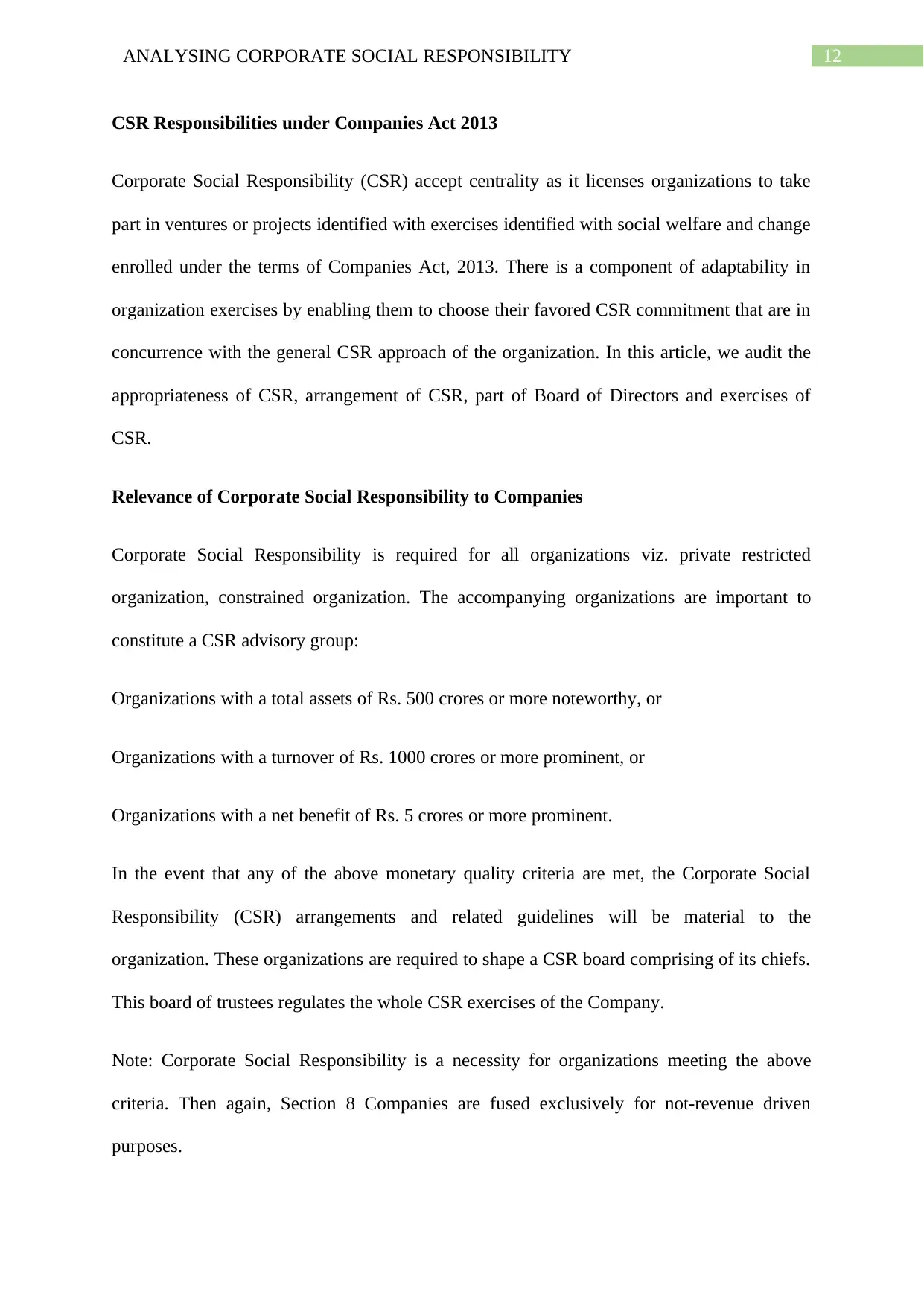
12ANALYSING CORPORATE SOCIAL RESPONSIBILITY
CSR Responsibilities under Companies Act 2013
Corporate Social Responsibility (CSR) accept centrality as it licenses organizations to take
part in ventures or projects identified with exercises identified with social welfare and change
enrolled under the terms of Companies Act, 2013. There is a component of adaptability in
organization exercises by enabling them to choose their favored CSR commitment that are in
concurrence with the general CSR approach of the organization. In this article, we audit the
appropriateness of CSR, arrangement of CSR, part of Board of Directors and exercises of
CSR.
Relevance of Corporate Social Responsibility to Companies
Corporate Social Responsibility is required for all organizations viz. private restricted
organization, constrained organization. The accompanying organizations are important to
constitute a CSR advisory group:
Organizations with a total assets of Rs. 500 crores or more noteworthy, or
Organizations with a turnover of Rs. 1000 crores or more prominent, or
Organizations with a net benefit of Rs. 5 crores or more prominent.
In the event that any of the above monetary quality criteria are met, the Corporate Social
Responsibility (CSR) arrangements and related guidelines will be material to the
organization. These organizations are required to shape a CSR board comprising of its chiefs.
This board of trustees regulates the whole CSR exercises of the Company.
Note: Corporate Social Responsibility is a necessity for organizations meeting the above
criteria. Then again, Section 8 Companies are fused exclusively for not-revenue driven
purposes.
CSR Responsibilities under Companies Act 2013
Corporate Social Responsibility (CSR) accept centrality as it licenses organizations to take
part in ventures or projects identified with exercises identified with social welfare and change
enrolled under the terms of Companies Act, 2013. There is a component of adaptability in
organization exercises by enabling them to choose their favored CSR commitment that are in
concurrence with the general CSR approach of the organization. In this article, we audit the
appropriateness of CSR, arrangement of CSR, part of Board of Directors and exercises of
CSR.
Relevance of Corporate Social Responsibility to Companies
Corporate Social Responsibility is required for all organizations viz. private restricted
organization, constrained organization. The accompanying organizations are important to
constitute a CSR advisory group:
Organizations with a total assets of Rs. 500 crores or more noteworthy, or
Organizations with a turnover of Rs. 1000 crores or more prominent, or
Organizations with a net benefit of Rs. 5 crores or more prominent.
In the event that any of the above monetary quality criteria are met, the Corporate Social
Responsibility (CSR) arrangements and related guidelines will be material to the
organization. These organizations are required to shape a CSR board comprising of its chiefs.
This board of trustees regulates the whole CSR exercises of the Company.
Note: Corporate Social Responsibility is a necessity for organizations meeting the above
criteria. Then again, Section 8 Companies are fused exclusively for not-revenue driven
purposes.
Paraphrase This Document
Need a fresh take? Get an instant paraphrase of this document with our AI Paraphraser
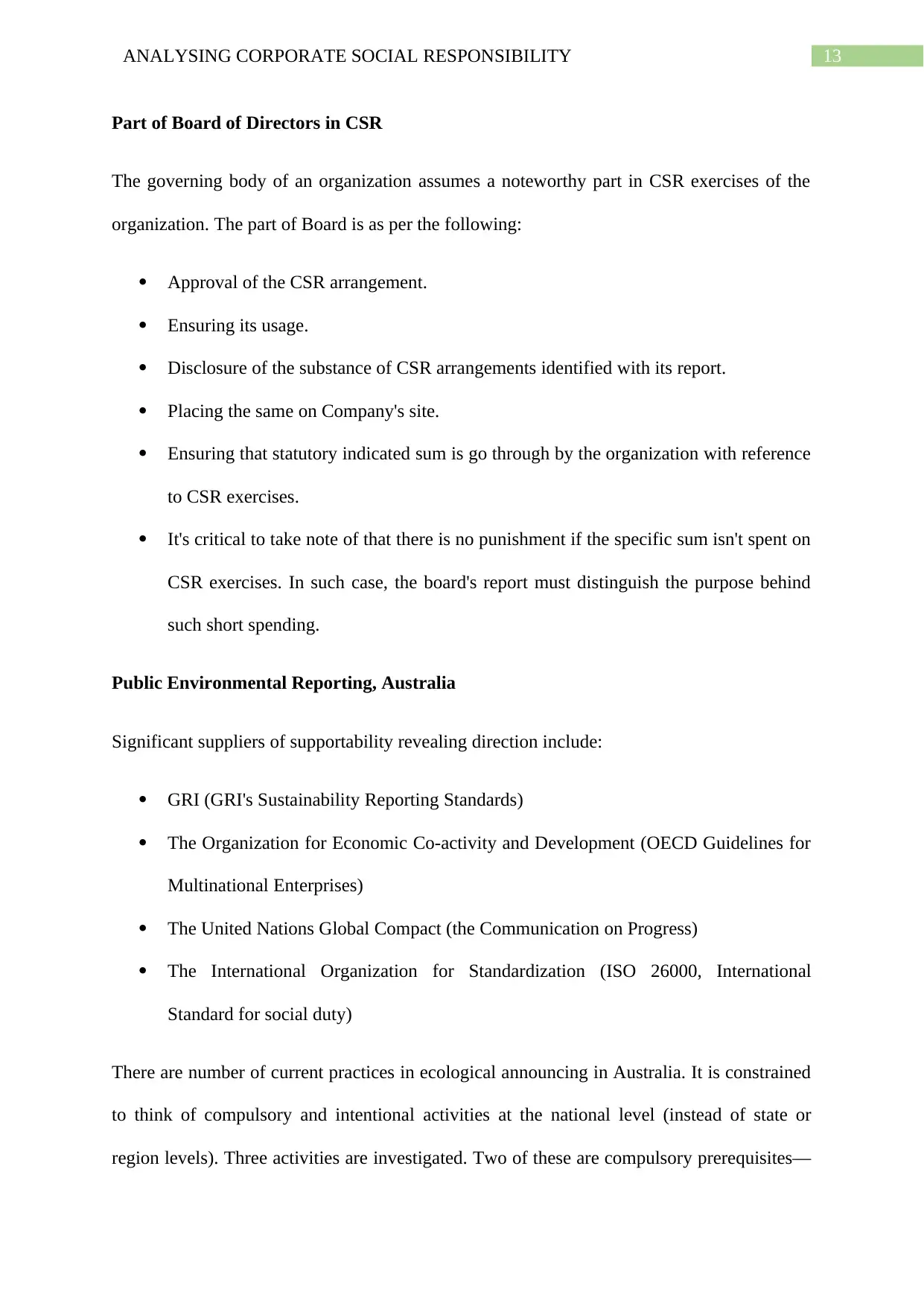
13ANALYSING CORPORATE SOCIAL RESPONSIBILITY
Part of Board of Directors in CSR
The governing body of an organization assumes a noteworthy part in CSR exercises of the
organization. The part of Board is as per the following:
Approval of the CSR arrangement.
Ensuring its usage.
Disclosure of the substance of CSR arrangements identified with its report.
Placing the same on Company's site.
Ensuring that statutory indicated sum is go through by the organization with reference
to CSR exercises.
It's critical to take note of that there is no punishment if the specific sum isn't spent on
CSR exercises. In such case, the board's report must distinguish the purpose behind
such short spending.
Public Environmental Reporting, Australia
Significant suppliers of supportability revealing direction include:
GRI (GRI's Sustainability Reporting Standards)
The Organization for Economic Co-activity and Development (OECD Guidelines for
Multinational Enterprises)
The United Nations Global Compact (the Communication on Progress)
The International Organization for Standardization (ISO 26000, International
Standard for social duty)
There are number of current practices in ecological announcing in Australia. It is constrained
to think of compulsory and intentional activities at the national level (instead of state or
region levels). Three activities are investigated. Two of these are compulsory prerequisites—
Part of Board of Directors in CSR
The governing body of an organization assumes a noteworthy part in CSR exercises of the
organization. The part of Board is as per the following:
Approval of the CSR arrangement.
Ensuring its usage.
Disclosure of the substance of CSR arrangements identified with its report.
Placing the same on Company's site.
Ensuring that statutory indicated sum is go through by the organization with reference
to CSR exercises.
It's critical to take note of that there is no punishment if the specific sum isn't spent on
CSR exercises. In such case, the board's report must distinguish the purpose behind
such short spending.
Public Environmental Reporting, Australia
Significant suppliers of supportability revealing direction include:
GRI (GRI's Sustainability Reporting Standards)
The Organization for Economic Co-activity and Development (OECD Guidelines for
Multinational Enterprises)
The United Nations Global Compact (the Communication on Progress)
The International Organization for Standardization (ISO 26000, International
Standard for social duty)
There are number of current practices in ecological announcing in Australia. It is constrained
to think of compulsory and intentional activities at the national level (instead of state or
region levels). Three activities are investigated. Two of these are compulsory prerequisites—
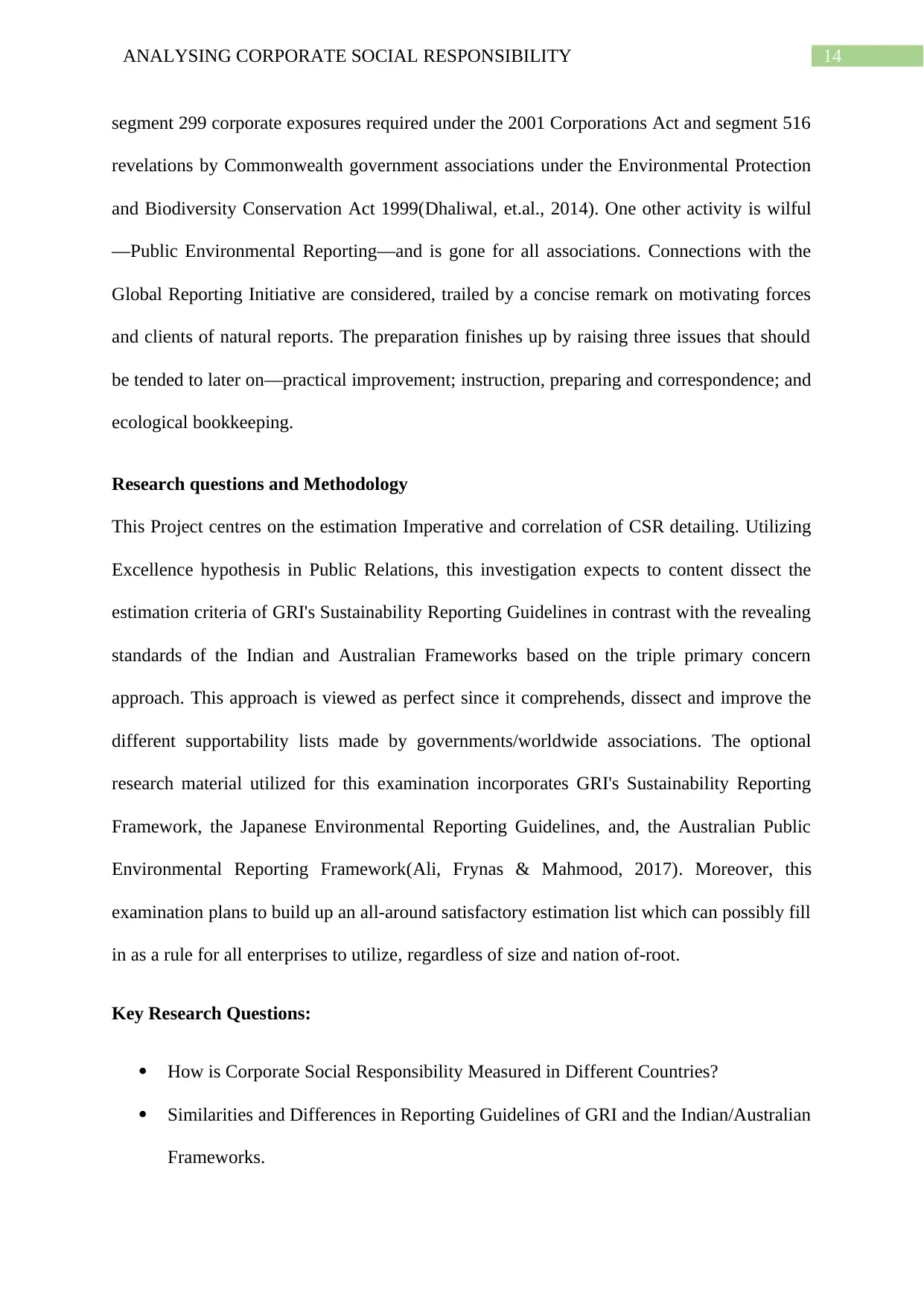
14ANALYSING CORPORATE SOCIAL RESPONSIBILITY
segment 299 corporate exposures required under the 2001 Corporations Act and segment 516
revelations by Commonwealth government associations under the Environmental Protection
and Biodiversity Conservation Act 1999(Dhaliwal, et.al., 2014). One other activity is wilful
—Public Environmental Reporting—and is gone for all associations. Connections with the
Global Reporting Initiative are considered, trailed by a concise remark on motivating forces
and clients of natural reports. The preparation finishes up by raising three issues that should
be tended to later on—practical improvement; instruction, preparing and correspondence; and
ecological bookkeeping.
Research questions and Methodology
This Project centres on the estimation Imperative and correlation of CSR detailing. Utilizing
Excellence hypothesis in Public Relations, this investigation expects to content dissect the
estimation criteria of GRI's Sustainability Reporting Guidelines in contrast with the revealing
standards of the Indian and Australian Frameworks based on the triple primary concern
approach. This approach is viewed as perfect since it comprehends, dissect and improve the
different supportability lists made by governments/worldwide associations. The optional
research material utilized for this examination incorporates GRI's Sustainability Reporting
Framework, the Japanese Environmental Reporting Guidelines, and, the Australian Public
Environmental Reporting Framework(Ali, Frynas & Mahmood, 2017). Moreover, this
examination plans to build up an all-around satisfactory estimation list which can possibly fill
in as a rule for all enterprises to utilize, regardless of size and nation of-root.
Key Research Questions:
How is Corporate Social Responsibility Measured in Different Countries?
Similarities and Differences in Reporting Guidelines of GRI and the Indian/Australian
Frameworks.
segment 299 corporate exposures required under the 2001 Corporations Act and segment 516
revelations by Commonwealth government associations under the Environmental Protection
and Biodiversity Conservation Act 1999(Dhaliwal, et.al., 2014). One other activity is wilful
—Public Environmental Reporting—and is gone for all associations. Connections with the
Global Reporting Initiative are considered, trailed by a concise remark on motivating forces
and clients of natural reports. The preparation finishes up by raising three issues that should
be tended to later on—practical improvement; instruction, preparing and correspondence; and
ecological bookkeeping.
Research questions and Methodology
This Project centres on the estimation Imperative and correlation of CSR detailing. Utilizing
Excellence hypothesis in Public Relations, this investigation expects to content dissect the
estimation criteria of GRI's Sustainability Reporting Guidelines in contrast with the revealing
standards of the Indian and Australian Frameworks based on the triple primary concern
approach. This approach is viewed as perfect since it comprehends, dissect and improve the
different supportability lists made by governments/worldwide associations. The optional
research material utilized for this examination incorporates GRI's Sustainability Reporting
Framework, the Japanese Environmental Reporting Guidelines, and, the Australian Public
Environmental Reporting Framework(Ali, Frynas & Mahmood, 2017). Moreover, this
examination plans to build up an all-around satisfactory estimation list which can possibly fill
in as a rule for all enterprises to utilize, regardless of size and nation of-root.
Key Research Questions:
How is Corporate Social Responsibility Measured in Different Countries?
Similarities and Differences in Reporting Guidelines of GRI and the Indian/Australian
Frameworks.
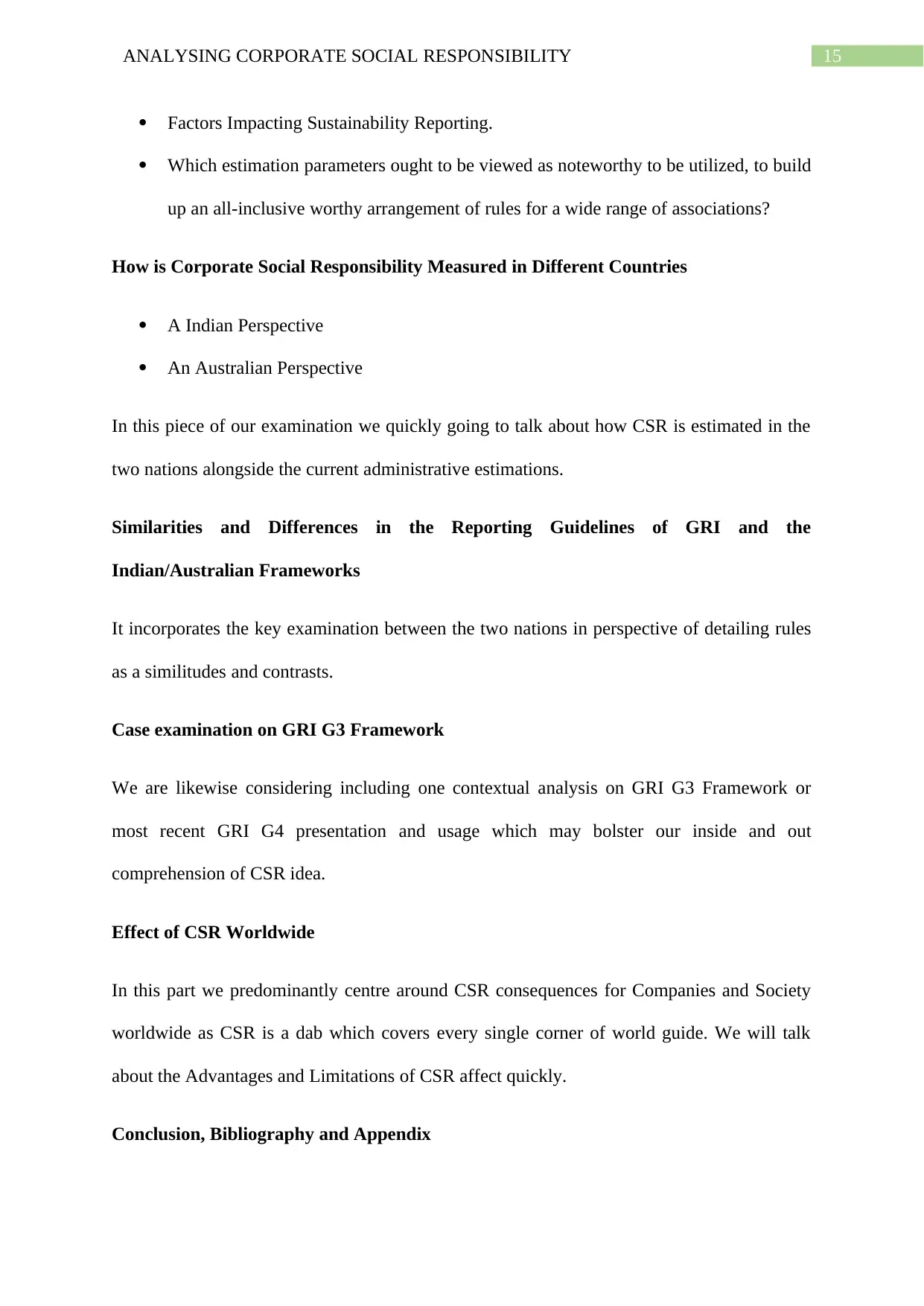
15ANALYSING CORPORATE SOCIAL RESPONSIBILITY
Factors Impacting Sustainability Reporting.
Which estimation parameters ought to be viewed as noteworthy to be utilized, to build
up an all-inclusive worthy arrangement of rules for a wide range of associations?
How is Corporate Social Responsibility Measured in Different Countries
A Indian Perspective
An Australian Perspective
In this piece of our examination we quickly going to talk about how CSR is estimated in the
two nations alongside the current administrative estimations.
Similarities and Differences in the Reporting Guidelines of GRI and the
Indian/Australian Frameworks
It incorporates the key examination between the two nations in perspective of detailing rules
as a similitudes and contrasts.
Case examination on GRI G3 Framework
We are likewise considering including one contextual analysis on GRI G3 Framework or
most recent GRI G4 presentation and usage which may bolster our inside and out
comprehension of CSR idea.
Effect of CSR Worldwide
In this part we predominantly centre around CSR consequences for Companies and Society
worldwide as CSR is a dab which covers every single corner of world guide. We will talk
about the Advantages and Limitations of CSR affect quickly.
Conclusion, Bibliography and Appendix
Factors Impacting Sustainability Reporting.
Which estimation parameters ought to be viewed as noteworthy to be utilized, to build
up an all-inclusive worthy arrangement of rules for a wide range of associations?
How is Corporate Social Responsibility Measured in Different Countries
A Indian Perspective
An Australian Perspective
In this piece of our examination we quickly going to talk about how CSR is estimated in the
two nations alongside the current administrative estimations.
Similarities and Differences in the Reporting Guidelines of GRI and the
Indian/Australian Frameworks
It incorporates the key examination between the two nations in perspective of detailing rules
as a similitudes and contrasts.
Case examination on GRI G3 Framework
We are likewise considering including one contextual analysis on GRI G3 Framework or
most recent GRI G4 presentation and usage which may bolster our inside and out
comprehension of CSR idea.
Effect of CSR Worldwide
In this part we predominantly centre around CSR consequences for Companies and Society
worldwide as CSR is a dab which covers every single corner of world guide. We will talk
about the Advantages and Limitations of CSR affect quickly.
Conclusion, Bibliography and Appendix
Secure Best Marks with AI Grader
Need help grading? Try our AI Grader for instant feedback on your assignments.
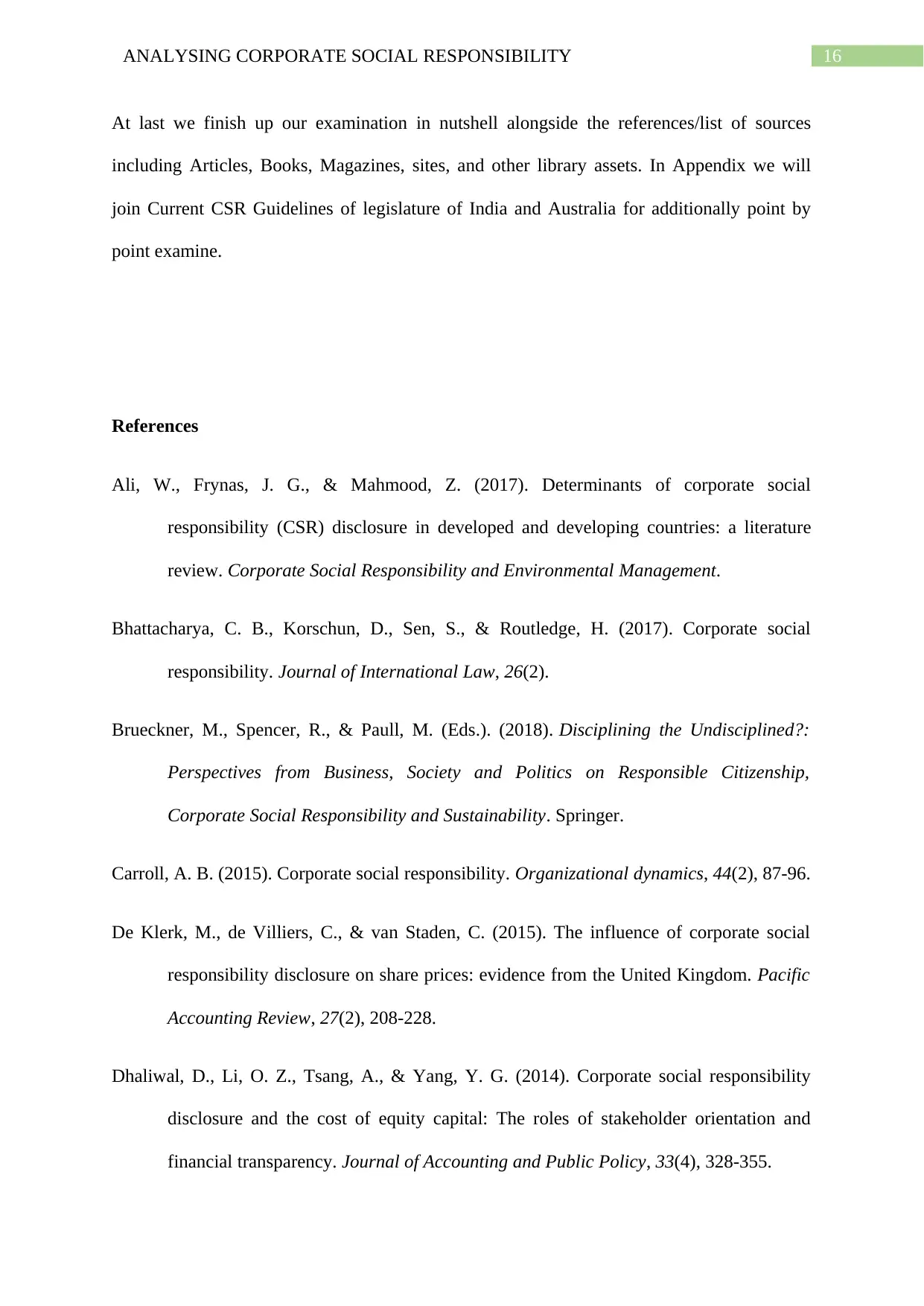
16ANALYSING CORPORATE SOCIAL RESPONSIBILITY
At last we finish up our examination in nutshell alongside the references/list of sources
including Articles, Books, Magazines, sites, and other library assets. In Appendix we will
join Current CSR Guidelines of legislature of India and Australia for additionally point by
point examine.
References
Ali, W., Frynas, J. G., & Mahmood, Z. (2017). Determinants of corporate social
responsibility (CSR) disclosure in developed and developing countries: a literature
review. Corporate Social Responsibility and Environmental Management.
Bhattacharya, C. B., Korschun, D., Sen, S., & Routledge, H. (2017). Corporate social
responsibility. Journal of International Law, 26(2).
Brueckner, M., Spencer, R., & Paull, M. (Eds.). (2018). Disciplining the Undisciplined?:
Perspectives from Business, Society and Politics on Responsible Citizenship,
Corporate Social Responsibility and Sustainability. Springer.
Carroll, A. B. (2015). Corporate social responsibility. Organizational dynamics, 44(2), 87-96.
De Klerk, M., de Villiers, C., & van Staden, C. (2015). The influence of corporate social
responsibility disclosure on share prices: evidence from the United Kingdom. Pacific
Accounting Review, 27(2), 208-228.
Dhaliwal, D., Li, O. Z., Tsang, A., & Yang, Y. G. (2014). Corporate social responsibility
disclosure and the cost of equity capital: The roles of stakeholder orientation and
financial transparency. Journal of Accounting and Public Policy, 33(4), 328-355.
At last we finish up our examination in nutshell alongside the references/list of sources
including Articles, Books, Magazines, sites, and other library assets. In Appendix we will
join Current CSR Guidelines of legislature of India and Australia for additionally point by
point examine.
References
Ali, W., Frynas, J. G., & Mahmood, Z. (2017). Determinants of corporate social
responsibility (CSR) disclosure in developed and developing countries: a literature
review. Corporate Social Responsibility and Environmental Management.
Bhattacharya, C. B., Korschun, D., Sen, S., & Routledge, H. (2017). Corporate social
responsibility. Journal of International Law, 26(2).
Brueckner, M., Spencer, R., & Paull, M. (Eds.). (2018). Disciplining the Undisciplined?:
Perspectives from Business, Society and Politics on Responsible Citizenship,
Corporate Social Responsibility and Sustainability. Springer.
Carroll, A. B. (2015). Corporate social responsibility. Organizational dynamics, 44(2), 87-96.
De Klerk, M., de Villiers, C., & van Staden, C. (2015). The influence of corporate social
responsibility disclosure on share prices: evidence from the United Kingdom. Pacific
Accounting Review, 27(2), 208-228.
Dhaliwal, D., Li, O. Z., Tsang, A., & Yang, Y. G. (2014). Corporate social responsibility
disclosure and the cost of equity capital: The roles of stakeholder orientation and
financial transparency. Journal of Accounting and Public Policy, 33(4), 328-355.
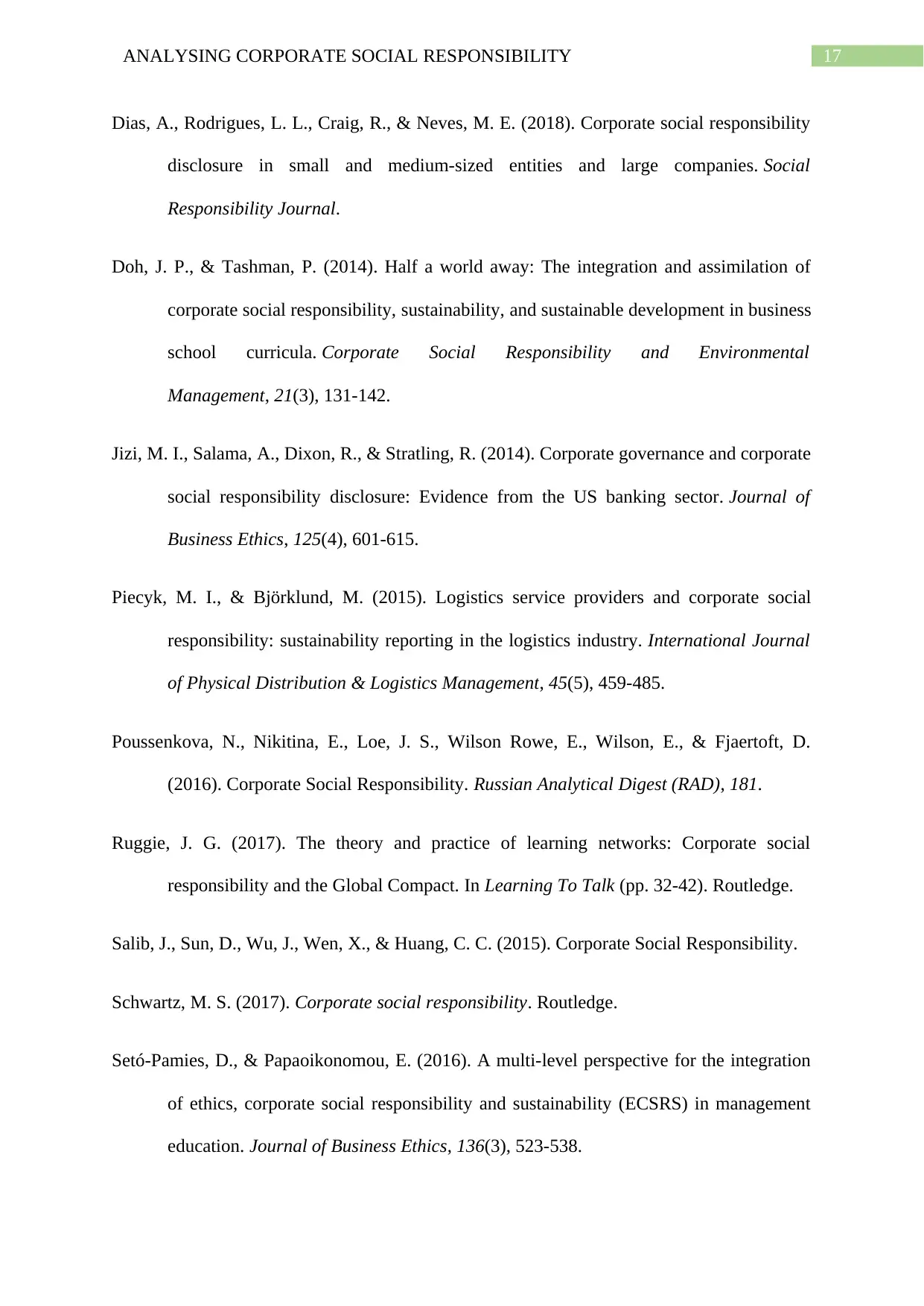
17ANALYSING CORPORATE SOCIAL RESPONSIBILITY
Dias, A., Rodrigues, L. L., Craig, R., & Neves, M. E. (2018). Corporate social responsibility
disclosure in small and medium-sized entities and large companies. Social
Responsibility Journal.
Doh, J. P., & Tashman, P. (2014). Half a world away: The integration and assimilation of
corporate social responsibility, sustainability, and sustainable development in business
school curricula. Corporate Social Responsibility and Environmental
Management, 21(3), 131-142.
Jizi, M. I., Salama, A., Dixon, R., & Stratling, R. (2014). Corporate governance and corporate
social responsibility disclosure: Evidence from the US banking sector. Journal of
Business Ethics, 125(4), 601-615.
Piecyk, M. I., & Björklund, M. (2015). Logistics service providers and corporate social
responsibility: sustainability reporting in the logistics industry. International Journal
of Physical Distribution & Logistics Management, 45(5), 459-485.
Poussenkova, N., Nikitina, E., Loe, J. S., Wilson Rowe, E., Wilson, E., & Fjaertoft, D.
(2016). Corporate Social Responsibility. Russian Analytical Digest (RAD), 181.
Ruggie, J. G. (2017). The theory and practice of learning networks: Corporate social
responsibility and the Global Compact. In Learning To Talk (pp. 32-42). Routledge.
Salib, J., Sun, D., Wu, J., Wen, X., & Huang, C. C. (2015). Corporate Social Responsibility.
Schwartz, M. S. (2017). Corporate social responsibility. Routledge.
Setó-Pamies, D., & Papaoikonomou, E. (2016). A multi-level perspective for the integration
of ethics, corporate social responsibility and sustainability (ECSRS) in management
education. Journal of Business Ethics, 136(3), 523-538.
Dias, A., Rodrigues, L. L., Craig, R., & Neves, M. E. (2018). Corporate social responsibility
disclosure in small and medium-sized entities and large companies. Social
Responsibility Journal.
Doh, J. P., & Tashman, P. (2014). Half a world away: The integration and assimilation of
corporate social responsibility, sustainability, and sustainable development in business
school curricula. Corporate Social Responsibility and Environmental
Management, 21(3), 131-142.
Jizi, M. I., Salama, A., Dixon, R., & Stratling, R. (2014). Corporate governance and corporate
social responsibility disclosure: Evidence from the US banking sector. Journal of
Business Ethics, 125(4), 601-615.
Piecyk, M. I., & Björklund, M. (2015). Logistics service providers and corporate social
responsibility: sustainability reporting in the logistics industry. International Journal
of Physical Distribution & Logistics Management, 45(5), 459-485.
Poussenkova, N., Nikitina, E., Loe, J. S., Wilson Rowe, E., Wilson, E., & Fjaertoft, D.
(2016). Corporate Social Responsibility. Russian Analytical Digest (RAD), 181.
Ruggie, J. G. (2017). The theory and practice of learning networks: Corporate social
responsibility and the Global Compact. In Learning To Talk (pp. 32-42). Routledge.
Salib, J., Sun, D., Wu, J., Wen, X., & Huang, C. C. (2015). Corporate Social Responsibility.
Schwartz, M. S. (2017). Corporate social responsibility. Routledge.
Setó-Pamies, D., & Papaoikonomou, E. (2016). A multi-level perspective for the integration
of ethics, corporate social responsibility and sustainability (ECSRS) in management
education. Journal of Business Ethics, 136(3), 523-538.
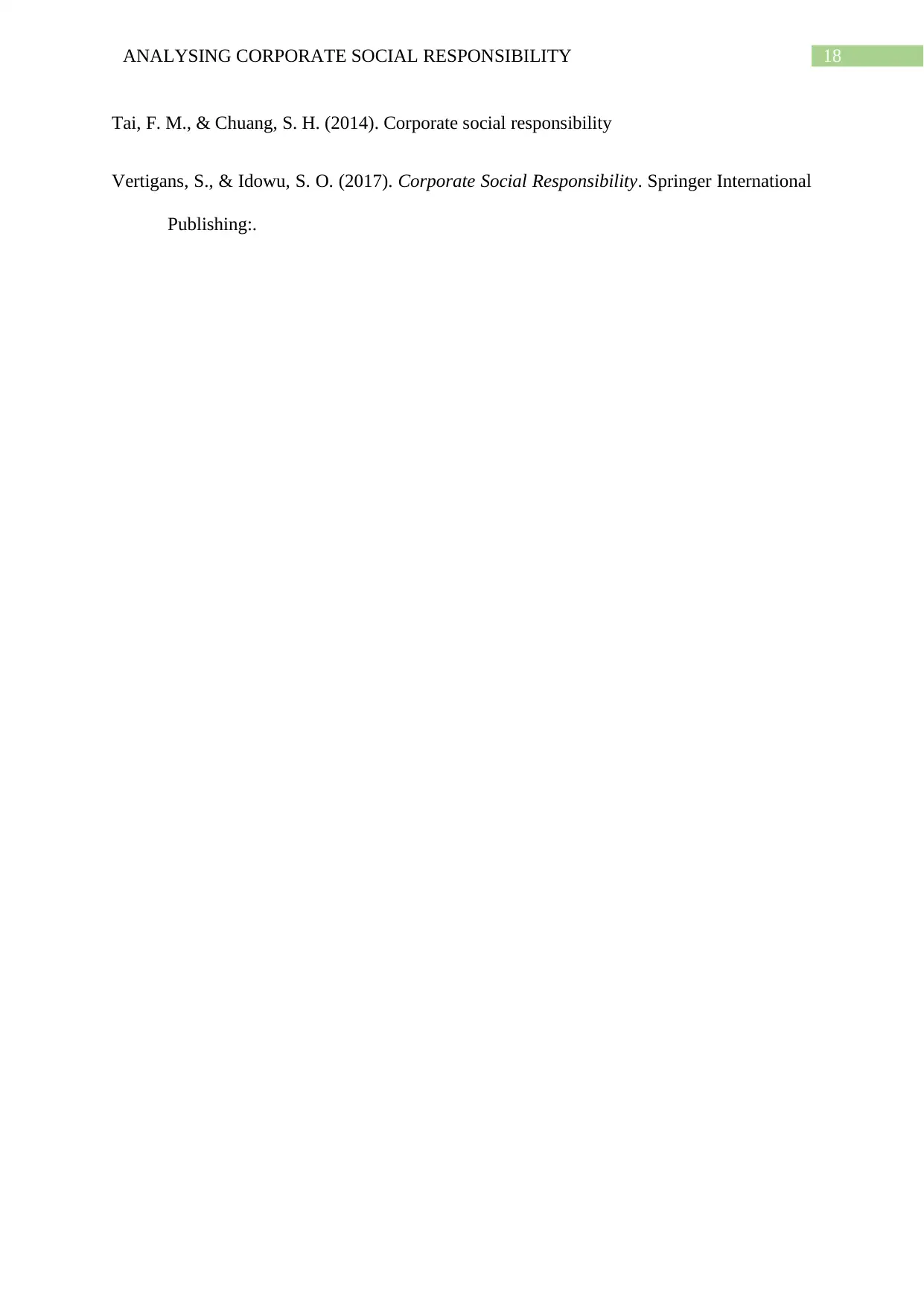
18ANALYSING CORPORATE SOCIAL RESPONSIBILITY
Tai, F. M., & Chuang, S. H. (2014). Corporate social responsibility
Vertigans, S., & Idowu, S. O. (2017). Corporate Social Responsibility. Springer International
Publishing:.
Tai, F. M., & Chuang, S. H. (2014). Corporate social responsibility
Vertigans, S., & Idowu, S. O. (2017). Corporate Social Responsibility. Springer International
Publishing:.
1 out of 19
Related Documents
Your All-in-One AI-Powered Toolkit for Academic Success.
+13062052269
info@desklib.com
Available 24*7 on WhatsApp / Email
![[object Object]](/_next/static/media/star-bottom.7253800d.svg)
Unlock your academic potential
© 2024 | Zucol Services PVT LTD | All rights reserved.





